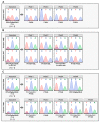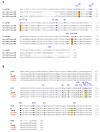Virus Host Jumping Can Be Boosted by Adaptation to a Bridge Plant Species
- PMID: 33920394
- PMCID: PMC8070427
- DOI: 10.3390/microorganisms9040805
Virus Host Jumping Can Be Boosted by Adaptation to a Bridge Plant Species
Abstract
Understanding biological mechanisms that regulate emergence of viral diseases, in particular those events engaging cross-species pathogens spillover, is becoming increasingly important in virology. Species barrier jumping has been extensively studied in animal viruses, and the critical role of a suitable intermediate host in animal viruses-generated human pandemics is highly topical. However, studies on host jumping involving plant viruses have been focused on shifting intra-species, leaving aside the putative role of "bridge hosts" in facilitating interspecies crossing. Here, we take advantage of several VPg mutants, derived from a chimeric construct of the potyvirus Plum pox virus (PPV), analyzing its differential behaviour in three herbaceous species. Our results showed that two VPg mutations in a Nicotiana clevelandii-adapted virus, emerged during adaptation to the bridge-host Arabidopsis thaliana, drastically prompted partial adaptation to Chenopodium foetidum. Although both changes are expected to facilitate productive interactions with eIF(iso)4E, polymorphims detected in PPV VPg and the three eIF(iso)4E studied, extrapolated to a recent VPg:eIF4E structural model, suggested that two adaptation ways can be operating. Remarkably, we found that VPg mutations driving host-range expansion in two non-related species, not only are not associated with cost trade-off constraints in the original host, but also improve fitness on it.
Keywords: Plum pox virus; RNA virus; VPg; eIF4E; host jumping; plant virus; potyvirus; trade-off; viral evolution.
Conflict of interest statement
The authors declare that there is no conflict of interest.
Figures





References
Grants and funding
LinkOut - more resources
Full Text Sources
Other Literature Sources

